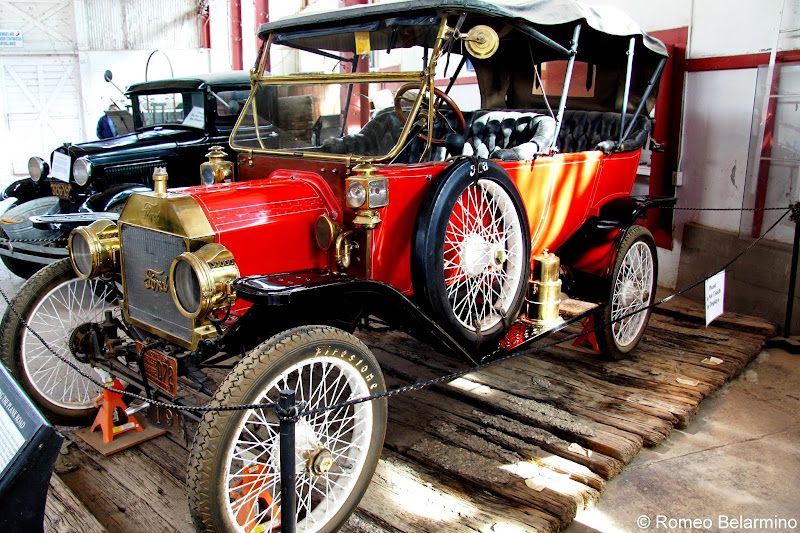Imagine Southern California in the early 1900s. It wasn’t as easy to travel as it is today, but the love of travel was strong. People wanted to explore and get away, and they were willing to do some pretty crazy things to do so. Crazy like crossing the ever-shifting sands of the Southern California desert on a road made entirely of wooden planks. The even crazier thing? There’s still a little piece of that Plank Road, built 100 years ago, available for travelers of today to visit.
I first learned about the Plank Road at the San Diego Automotive Museum in Balboa Park. It was just a little display in the corner of the museum that I almost missed. I watched the documentary and read the plaques and I was immediately obsessed.
The idea of a Plank Road started with a rivalry between two cities, San Diego and Los Angeles. San Diego had lost its bid to be the location of a terminus for the Transcontinental Railroad, so the next plan was to beat Los Angeles to becoming a road network hub. “Colonel” Ed Fletcher was a road builder and wanted to prove that San Diego was a better choice for a route between California and Arizona. In October 1912, Fletcher raced a reporter for the Examiner. Fletcher was to travel from San Diego to Phoenix and the reporter was to travel from Los Angeles to Phoenix, each hoping to prove their city provided the better route. Fletcher won the race in 19.5 hours, even with his automobile being pulled through the Imperial sand dunes by a team of horses.
 |
The approval of construction of the Ocean-to-Ocean Highway bridge crossing the Colorado River in Yuma contributed to the success of the Plank Road plans. |
Plans began to create a road between San Diego and Yuma, passing through Imperial County. San Diego was planning the 1915 Panama-California Exposition to celebrate the opening of the Panama Canal and thousands of visitors would be arriving by automobile. A road across the sand dunes was needed.
Related: A Weekend Exploring Yuma’s Historic Districts
Related: A Weekend Exploring Yuma’s Historic Districts
The Plank Road started as a track of 25-inch wide parallel planks extending almost seven miles across the sands east of Grey’s Wells. Just imagine accidentally coming off such a narrow track into soft, deep sand! In April 1915, the first automobiles crossed the Plank Road. The Plank Road got beat up pretty quickly by all the traffic it saw, so the road had to soon be upgraded.
 |
| The original Plank Road was just a track of parallel planks like those in the forefront. |
The next Plank Road was a little sturdier. In 1916, the new plank road was made of wood railroad ties laid to create an eight-foot wide road. Every 1,000 feet the road doubled in size to allow for passing. While the road was constantly being covered by sand from the dunes and traffic jams occurred on the wooden road floating on a sea of sand, travelers still loved the sense of adventure they gained from traversing this road connecting Arizona to the California coast.
The Plank Road was no longer necessary in 1926 when a 20-foot wide asphalt highway was built. Now Interstate 8, which may never have existed if it weren’t for the Plank Road, allows millions of travelers to drive back and forth between San Diego and Yuma and beyond.
Related: A Small Town Wild West Weekend in Yuma
What is astonishing is part of this historic road still exists. The area around the remaining piece of the Plank Road is a very popular destination. The Imperial Sand Dunes Recreation Area attracts off-road enthusiasts who want to climb the sand dunes in ATVs. Yet many of the sand dunes visitors don’t even know the Plank Road exists.
The remains of the Plank Road, 20 miles west of Yuma, can be reached by exiting Interstate 8 at the Grays Wells Road exit and following the road southwest until the road dead ends. Here you will find a small parking lot with a plaque marking California Registered Historical Landmark No. 845. Climb the slight sand hill and you’ll see the remains of the Plank Road, some parts very well preserved, looking much like they did in the early 1920s, while other parts are just small remnants of rotting wood. Walking along this little-known piece of Americana, I could hardly imagine driving along this rickety, narrow road at 10 miles per hour during a time before automobile suspension was perfected, in the middle of nowhere. The surroundings are other-worldly, so much so the dunes were used as the setting of another planet in Star Wars.
 |
| Imagine crossing miles of this landscape on a road made of wood. |
Out in the middle of the desert isn’t the only place where the Plank Road can be seen. At the Yuma Quartermaster Depot State Historic Park visitors can see a well-preserved piece of the Plank Road amidst classic cars. Commentary from people who had traveled along the Plank Road is displayed, recalling traffic jams and bouncing around so much, items bounced out of cars unbeknownst to the drivers.
 |
| A piece of the Plank Road at the Yuma Quartermaster Depot. |
Visiting what remains of the historic Plank Road is definitely off the beaten path. You only need 15 minutes or so to follow the length of the road, but it is fascinating to see this artifact from a time long past. If you’re ever heading out to the Imperial Sand Dunes or traveling between San Diego and Yuma, be sure to pull off the highway to see the old Plank Road.






